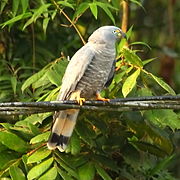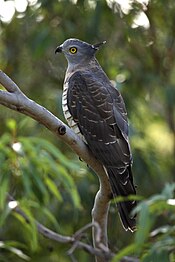Perninae
 From Wikipedia - Reading time: 5 min
From Wikipedia - Reading time: 5 min
| Perninae | |
|---|---|

| |
| Pacific baza (Aviceda subcristata) | |
| Scientific classification | |
| Domain: | Eukaryota |
| Kingdom: | Animalia |
| Phylum: | Chordata |
| Class: | Aves |
| Order: | Accipitriformes |
| Family: | Accipitridae |
| Subfamily: | Perninae Blyth, 1851 |
The raptor subfamily Perninae includes a number of medium-sized broad-winged species. These are birds of warmer climates, although the Pernis species (European honey buzzard and crested honey buzzard) have a more extensive range.
Several of the species in this group eat mainly insects, and the honey-buzzards are specialist feeders on wasp larvae. Reptiles are also taken by several birds in this group.
Several authorities consider Gypaetinae to be within or even synonymous with Perninae.[1][2]
Taxonomy
[edit]The cladogram of the Perninae shown below is based on a molecular phylogenetic study of the Accipitridae by Therese Catanach and collaborators that was published in 2024.[3]
| Perninae |
| ||||||||||||||||||||||||||||||||||||||||||||||||
Genera
[edit]| Image | Genus | Living species |
|---|---|---|
 |
Eutriorchis Sharpe, 1875 |
|
 |
Chondrohierax Lesson, 1843 |
|
 |
Leptodon Sundevall, 1836 |
|
 |
Aviceda Swainson, 1836 |
|
 |
Pernis Cuvier, 1816 |
|
 |
Elanoides Vieillot, 1818 |
|
 |
Hamirostra Brown, 1846 |
|
 |
Lophoictinia Kaup, 1847 |
|
| Henicopernis (Lesson & Garnot, 1828) |
|
References
[edit]- ^ Griffiths, C.S.; Barrowclough, G.F.; Groth, J.G.; Mertz, L.A. (2007). "Phylogeny, diversity, and classification of the Accipitridae based on DNA sequences of the RAG-1 exon". Journal of Avian Biology. 38 (5): 587–602. doi:10.1111/j.2007.0908-8857.03971.x.
- ^ Lerner, Heather R. L.; Mindell, David P. (2005). "Phylogeny of eagles, Old World vultures, and other Accipitridae based on nuclear and mitochondrial DNA". Molecular Phylogenetics and Evolution. 37 (2): 327–346. Bibcode:2005MolPE..37..327L. doi:10.1016/j.ympev.2005.04.010. PMID 15925523.
- ^ Catanach, T.A.; Halley, M.R.; Pirro, S. (2024). "Enigmas no longer: using ultraconserved elements to place several unusual hawk taxa and address the non-monophyly of the genus Accipiter (Accipitriformes: Accipitridae)". Biological Journal of the Linnean Society: blae028. doi:10.1093/biolinnean/blae028.
External links
[edit] Data related to Perninae at Wikispecies
Data related to Perninae at Wikispecies
 KSF
KSF